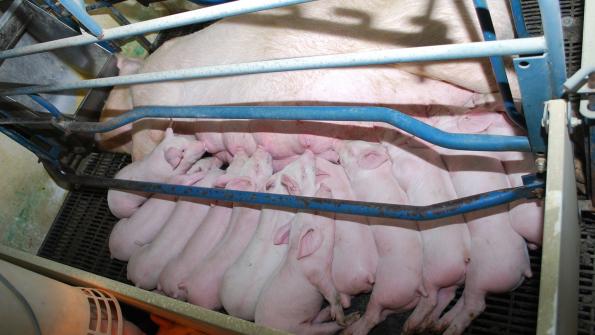USDA hog numbers on par with pre-report estimates
The December-February 2019 pig crop, at 32.99 million head, was up 2.8% from 2018, precisely the year-over-year change analysts had expected.

The USDA’s quarterly Hogs and Pigs report released today was neck and neck with analysts’ pre-report expectations. The U.S. inventory of all hogs and pigs on March 1 was 74.296 million head. This was up 2.1% from March 1, 2018. Steve Meyer, Kerns and Associates says Urner Barry analysts had pegged that number to be up 2%.
Breeding inventory, at 6.349 million head, was up 2.2% from last year, and up slightly from the previous quarter. Analysts had expected that number to be up 1.9%. Market hog inventory, at 67.948 million head, was up 2.1% from last year, exactly what analysts believed this number would be compared to a year ago.
United States hog producers intend to have 3.12 million sows farrow during the March-May 2019 quarter, up 1% from the actual farrowings during the same period in 2018, and up 3% from 2017. Intended farrowings for June-August 2019, at 3.19 million sows, are down slightly from 2018, but up 3% from 2017. Urner Barry analysts had expected that figure to be up 2.3% and that was the largest discrepancy versus analyst pre-report estimates.
The December-February 2019 pig crop, at 32.99 million head, was up 2.8% from 2018, precisely the year-over-year change analysts had expected. Sows farrowing during this period totaled 3.08 million head, up 2% from 2018. The sows farrowed during this quarter represented 49% of the breeding herd. The average pigs saved per litter was a record high of 10.70 for the December-February period, compared to 10.58 last year.
The total number of hogs under contract owned by operations with over 5,000 head, but raised by contractees, accounted for 47% of the total United States hog inventory, unchanged from the previous year.
Based on the numbers outlined, Kevin Grier, president of Kevin Grier Consulting and Analysis, based in Guelph, Canada, says he is looking for about a 2% increase in slaughter in second and third quarters and then based on farrowing intentions and normal increases in pigs per litter, 1% in both the fourth quarter 2019 and first quarter of 2020.
“There could perhaps be some skepticism with regards to that last farrowing intention, but giving it for what it is, I’m only looking for a 1% increase in slaughter in quarter one of 2020,” Grier says. “Again these are increases on top of huge, huge numbers and that’s really what the reality of it is – a lot of pork.”
John Nalivka, president, Sterling Marketing, Vale, Ore. says the U.S. “continues to have plenty of hogs; there is no doubt about that.”
“I think we see with the losses that occurred on the production side of this business going into the second half of last year and the first quarter of this year, there has been some slowing down of the expansion phase,” Nalivka says. “You can hold your breeding herd steady and your sows steady, but at the same time you continue to see that production efficiency and increased pace on that farrowing rate, so we continue to have these larger pig crops so it fills that gap going into this increased packer capacity.”
Meyer, Grier and Nalivka, along with Kevin Bost, president of Procurement Strategies, Elgin, Ill. were all participants on a Pork Checkoff-hosted conference call after the report was released this afternoon.
About the Author(s)
You May Also Like




